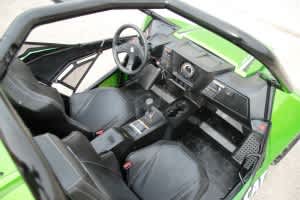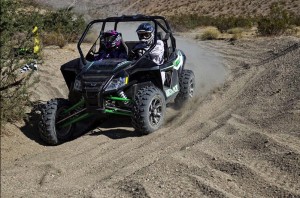Cruising Barstow in Arctic Cat’s New Wildcat 1000i H.O.
OutdoorHub 10.25.11

Look out Polaris! Cross-state nemesis Arctic Cat has set its engineering cross hairs directly on its arch rival’s hugely successful RZR XP 900 with the release of the all-new Wildcat — a pure-sport off-road side-by-side that revives the name of the departed muscle sled from the 1990s. The Wildcat has a powerful engine, trophy truck-style suspension, racer-friendly ergonomics and an “exoskeleton chassis” that’s designed to handle the toughest terrain on the planet.
Digging into the specifics, Arctic Cat’s new 2012 Wildcat 1000i H.O. is powered by the same 951cc V-Twin that serves duty atop the company’s ATV lineup. Lower and wider than its Prowler side-by-sides, the Wildcat has a radical 5-link rear suspension that has a whoop-crushing 18 inches of travel, while the front dual A-arms provide 17. The shocks are from Walker Evans, with compression adjustability, as well as a two-stage spring preload adjustment.
The rugged land near Barstow, California is the ideal place to evaluate the Wildcat, and where many off-road race teams do their testing.
Other key features include electric power steering to significantly tame bump steer, sharp aluminum rims, super-bright LED headlights and taillights, 14-inch rims, disc brakes at both ends, an automotive-grade paint job and a fan-cooled radiator mounted behind the seats — part of the packaging necessary to achieve the desired 40/60 front-to-rear weight balance.
With a modern, aggressive design penned by Nathan Blomker — the same graphic artist behind Arctic Cat’s new snowmobile chassis, the Wildcat is a huge leap for its off-road division, and takes the brand in a much sportier direction.
To put its claims to the test, we traveled to the Mojave Desert near Barstow, California for a day spent railing corners, hammering through sandy whoops and hitting jumps on the rough desert trails this vehicle was designed for. As media relations specialist Kale Wainer told the group about the harsh terrain, “If it works in Barstow, it will work anywhere.”
Riders sit low in the Wildcat, and engineers worked hard to achieve the ideal 40/60 front-to-rear weight distribution.
Within 5 minutes on the trail, it was clear that Polaris should be looking over its shoulder, as the Wildcat 1000i H.O. delivers performance that’s, at the least, on par with the RZR XP 900. Its incredible suspension is where the Wildcat pulls ahead with 3.5 more inches of travel in the front and 4 in the rear.
Going down desert trails at 60+ mph, the Wildcat feels more akin to a scaled down trophy truck than a consumer-bred off-road vehicle. Its lower seating position is apparent behind the wheel, which makes the driver feel more aggressive and ensconced inside the vehicle. Long stretches of whoops, large rocks or jumps are all handled with aplomb — the Wildcat has an uncommon ability to charge through rough terrain at high speeds with minimal jarring and neck thrashing than lesser machines.
Power output from the big V-Twin is adequate for a high-performance side-by-side, although not as thrilling as the Polaris ProStar 900 or as aurally pleasing as the Can-Am Commander’s Rotax 1000. With a larger 50mm throttle body, Cat’s 951cc twin puts out more power than its ATV applications, although company officials declined to release specific numbers. We’d guess the modifications boost its horsepower numbers to somewhere near 75.
We’d need to ride them back-to-back to say for sure, but it looks like Arctic Cat may have leapfrogged Polaris in the performance side-by-side wars.
Compared with the RZR XP 900, the Wildcat is nearly 12 inches longer and seven inches lower. They both share a 64-inch width, while the Wildcat is more than a 100 pounds heavier at a claimed weight of 1,300 pounds. With its agile moves, it never felt like a porker.
Inside the cab, riders are greeted with a comfortable interior that’s more performance-oriented than any version of the Prowler. High-back bucket seats envelop the riders, and minimal, door-like side panels open rearward for easy entry and exit. They look cool, and provide reassuring side protection.
Between the seats, the gearshift lever operates lightly and precisely. A centrally mounted digital and analog display shows speed and other vital information, and a locking passenger-side glove box and dual cup holders afford in-cab storage. A rear cargo box is rated to haul 300 pounds.
The steering wheel’s small diameter feels solid and sporty. Riders in both positions get false pedals for their outboard feet for stability when driving hard. In the passenger seat, a left-hand handhold was notably absent, although Wainer suggests final production models will include something to hang on to. Official pricing has been set at $16,599 — slightly higher than the RZR XP that begins at $15,999.
With the newly ignited rivalry between the Polaris and Arctic Cat taking to the dirt, it’s clear the choice between these two competitors will continue — on or off snow. The Arctic Cat Wildcat 100i H.O. hits dealers in late 2011 and early 2012.


